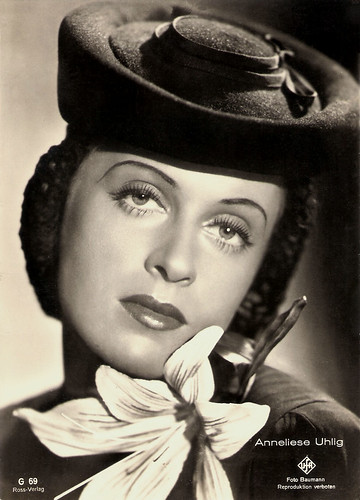
German postcard by Ross Verlag, no. G 69. Photo: Ufa / Baumann.
Anneliese Uhlig (1918-2017) was an elegant and enchanting femme fatale of Ufa crime films of the 1940s. The classic beauty unwillingly bewitched Joseph Goebbels. After the war, she worked internationally as a journalist, theatre producer and university teacher. She became an American citizen and died in Santa Cruz, California.
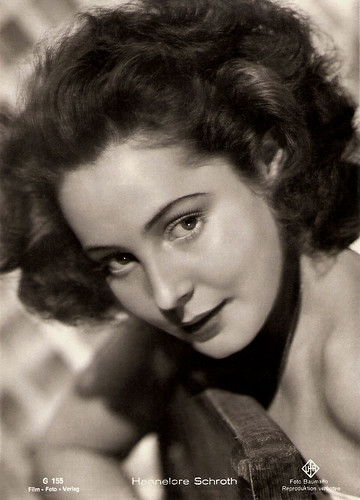
German postcard by Film-Foto-Verlag, no. G 155, 1941-1944. Photo: Baumann / Ufa.
German actress Hannelore Schroth (1922-1987) made her film debut at nine and had a long and successful career in theatre and cinema. She starred in Unter den Brücken/Under the Bridge (Helmut Käutner, 1945), one of the most beautiful love stories of German cinema – without any trace of propaganda.
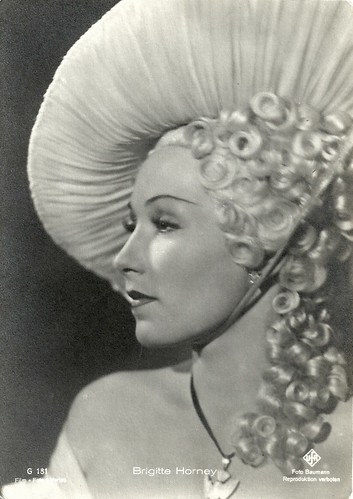
German postcard by Film-Foto-Verlag, no. G 181. Photo: Baumann / Ufa. Brigitte Horney in Münchhausen/The Adventures of Baron Munchausen (Josef von Báky, 1943).
Charismatic German theatre and film actress Brigitte Horney (1911-1988) worked in German and English films. Her earthy charm, prominent cheekbones and deep, sultry voice made her stand out from her colleagues. She is best remembered as Empress Katherine the Great in the lavish Ufa spectacle Münchhausen (1943). After the war, she moved to the US and became an American citizen.
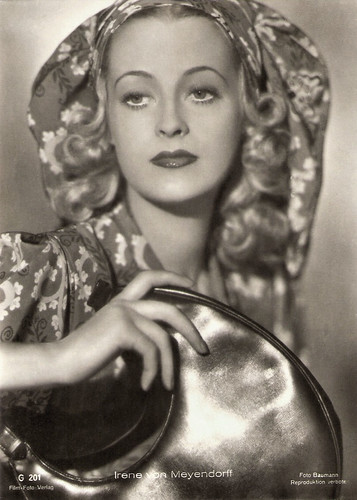
German postcard by Film-Foto-Verlag, no. G 201, 1941-1944. Photo: Foto Baumann.
Baroness Irene von Meyendorff (1916-2001) never planned to become a film star, but she appeared in more than 40 films. Unexpectedly, the breathtaking beautiful, ice-cold blonde became a star of the Ufa in the 1940s. Her beauty attracted Josef Goebbels, who got a harsh rebuff from her. After the war, she played several parts in interesting German films and led a full, remarkable life.

German postcard by Film-Foto-Verlag, no. G 212, 1941-1944. Photo: Baumann / Ufa.
German actress Mady Rahl (1915-2009) was the last of the female Ufa stars. She played in about 90 films, for the Ufa, and also in four decades after the war. On TV she was the German voice of Lucille Ball.
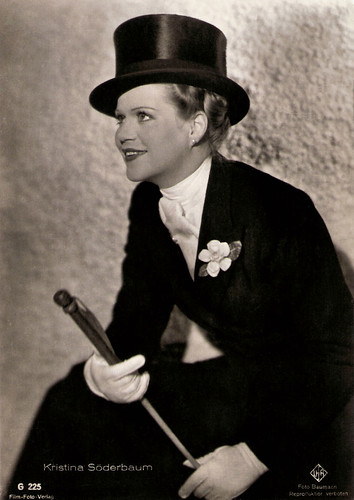
German postcard by Film-Foto-Verlag, no. G 225, 1941-1944. Photo: Baumann / Ufa. From Tatiana.
Swedish-born, German film actress Kristina Söderbaum (1912-2001) was considered the prototype of an Aryan woman during the Third Reich. The blonde, blue-eyed star played the lead in several Nazi propaganda films directed by her husband Veit Harlan. After the war, this would damage her career.
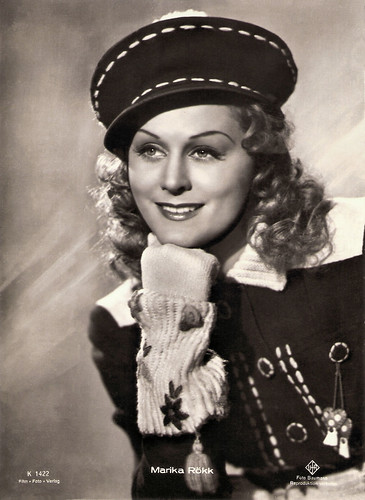
German postcard by Film-Foto-Verlag, no. K 1422. Photo: Baumann / Ufa.
Egyptian-born singer, dancer and actress of Hungarian descent Marika Rökk (1913-2004) was the last film diva of the Ufa. She was an immensely talented musical performer who could tap with the rhythm and vitality of her Hollywood counterpart Eleanor Powell, and switch to balletic movements with the conviction of Cyd Charisse. Her trade mark was her Hungarian accent.
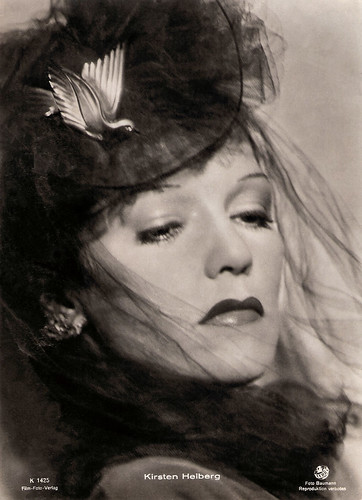
German postcard by Film-Foto-Verlag, no. K 1425. Photo: Baumann / Terra.
Beautiful Norwegian actress and singer Kirsten Heiberg (1907-1976) was the femme fatale of the German cinema of the Third Reich. The Ufa considered her a replacement for Marlene Dietrich after the latter left for Hollywood. ‘Die Heiberg’ was one of the most interesting and talented Ufa-stars, but unfortunately, she stayed somewhat in the shade of Zarah Leander.
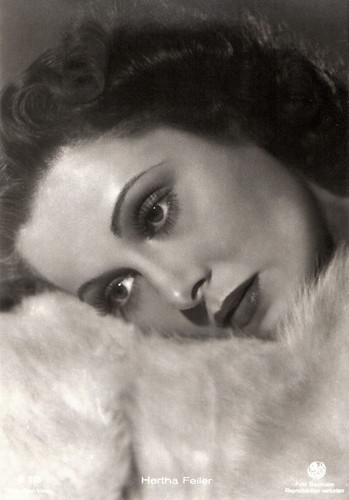
German postcard by Foto-Film-Verlag, no. S 185, 1941-1944. Photo: Baumann / Terra.
Beautiful Austrian actress Hertha Feiler (1916-1970) was the elegant and charming wife of Heinz Rühmann, off-screen and on-screen in many popular films of the 1940s and 1950s.
Who was Baumann?
Ernst Baumann was born in 1906 in Bad Reichenhall, Bavaria, Germany. After school, he attended the Fachschule für Korbflechterei (technical college for basket weaving) in Lichtenfels. In 1924, he was given a camera and from then on, he dedicated himself to photography. As early as 1926, he registered as a photographer. Baumann was a keen mountaineer and skier, and his photo series appeared in numerous alpine magazines. He published two books on mountain photography, 'Meine Berge, meine Kamera' (My Mountains, My Camera, 1935) and 'Fotografieren in den Bergen' (1936). From 1932 to 1939, he also worked as a still photographer for Luis Trenker's mountain films, including the historical drama Der Rebell/The Rebel (Kurt Bernhardt, Edwin H. Knopf, Luis Trenker, 1932), the drama Der verlorene Sohn/The Prodigal Son (Luis Trenker, 1934) and the Italian historical drama Condottieri (Luis Trenker, 1937).
In addition to his work in the Alps, he was a portrait photographer for the Ufa and a photo reporter for the Berliner Illustrirte Zeitung. He did also industrial reports for the automotive industry and travel reports in the Mediterranean and on the Atlantic islands. His glamour portraits for the Ufa were used for many postcards by Ross Verlag and Film-Foto-Verlag. He also made publicity stills for such Ufa productions as the romantic comedy Frau am Steuer/Woman at the Wheel (Paul Martin, 1939) starring Lilian Harvey, the historical drama Es war eine rauschende Ballnacht/The Life and Loves of Tschaikovsky (Carl Froelich, 1939) starring Zarah Leander and Marika Rökk, and Liebesgeschichten (Viktor Tourjansky, 1941-1942) with Willy Fritsch and Hannelore Schroth.
During the Second World War, Baumann was a war correspondent and cameraman for the Waffen-SS. As his reputation grew, he was transferred to the Berghof to serve as Eva Braun's official photographer. Guido Knopp in his book 'Hitler's Women': "Eva enjoyed making home movies and taking photos, and particularly liked being photographed herself. The pictures taken by a photographer named Ernst Baumann were among her favourites. His son-in-law tells us: 'She wished to have more pictures taken of herself. The shots that my father-in-law took of her were a purely private commission.'
However, the photographer got dangerously close to Hitler's mistress. Some of his shots found their way into gift albums - but many did not. Those too have been discovered in Baumann's archive. They show Eva in the late summer of 1941, relaxing in the sun, doing gymnastics, or bathing in the Koenigssee. The collection includes photos of her sister Gretl. 'The photos were never intended for anyone else to see,' says his son-in-law. But somehow they were seen by Martin Bormann, Hitler's secretary and chief factotum on the Obersalzberg. 'Towards the end of '41 [note: this was actually the fall of 1942], my father-in-law was suddenly posted to the front, without a word of warning. After the war, he found out from a former superior officer [note: Fritz Darges, former aide-de-camp at the Obersalzberg] that he should have actually been sent on a mission from which he was not meant to come back alive.' But the photographer survived - and so did his pictures."
After the war, Ernst Baumann returned to Bad Reichenhall from American captivity in 1947. There he rebuilt his photography business with an attached postcard publishing house. He kept making film star portraits. Baumann passed away in 1985 in Bad Reichenhall in Bavaria. He was 78. On 14 May 2006, a permanent exhibition of his work from his early creative period from 1925 to 1950 was opened in the mountain hotel on the Predigtstuhl near Bad Reichenhall to mark Ernst Baumann's 100th birthday.
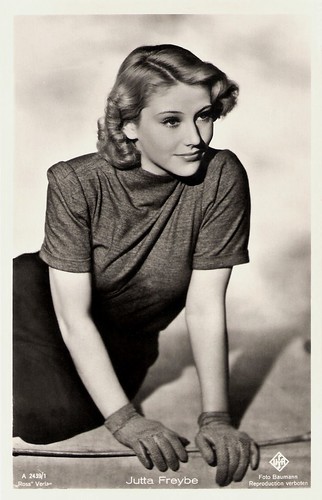
German postcard by Ross Verlag, no. A 2439/1, 1939-1940. Photo: Baumann / Ufa.
German stage and film actress Jutta Freybe (1917–1971) was the attractive blond leading lady in ten films during the Nazi era.

German postcard by Ross Verlag, no. A 2830/1, 1939-1940. Photo: Baumann / Terra.
Dancer, singer, and actress Ursula Deinert (1910-1988) was one of the dancing queens of the German light entertainment films of the late 1930s and the early 1940s.
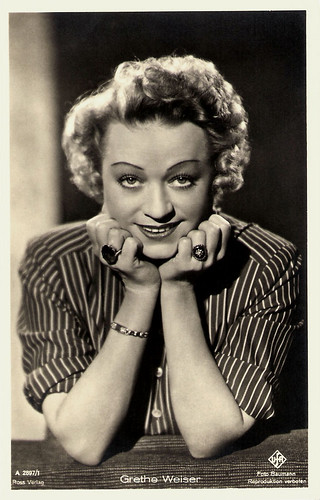
German postcard by Ross Verlag, no. A 2897/1, 1939-1940. Photo: Ufa / Baumann.
Grethe Weiser (1903–1970) was a German singer, comedian, film and stage actress. She made more than 140 films.
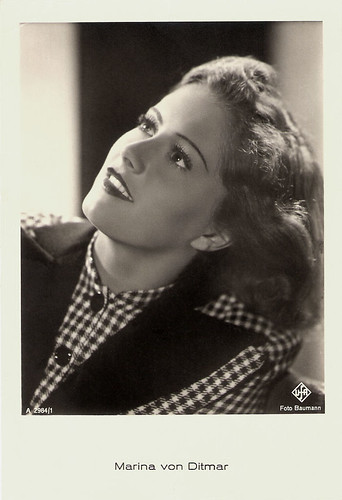
German postcard by Film-Foto-Verlag, no. A 2984/1, 1939-1940. Photo: Baumann / Ufa.
German Baltic theatre and film actress Marina von Ditmar (1914) was a popular film star of the Third Reich.
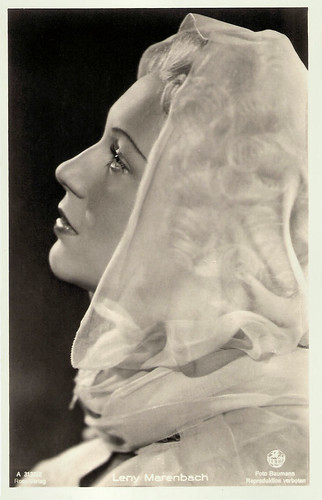
German postcard by Film-Foto-Verlag, no. A 3132/2, 1941-1944. Photo: Baumann / Terra.
Lady-like Leny Marenbach (1907–1984) was one of the leading Ufa stars in the Nazi era. The German actress appeared in several popular comedies with Heinz Rühmann, like the hit Der Mustergatte/The Model Husband (1937). After the Second World War, she only played in a few films for the Defa.
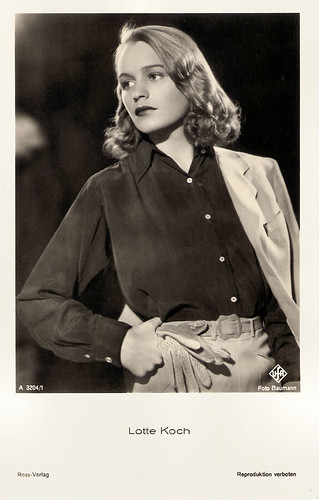
German postcard by Ross-Verlag, no. A 3204/1, 1941-1944. Photo: Baumann / Ufa.
German-Belgian actress Lotte Koch (1913-2013) appeared in Nazi propaganda films, but she also starred in Morituri (1948), the first German film about concentration camps and the Holocaust.
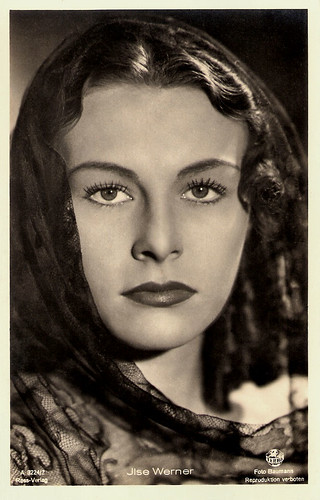
German postcard by Ross-Verlag, no. A 3224/2, 1941-1944. Photo: Baumann / Terra.
Dutch-born actress and singer Ilse Werner (1921-2005) was one of the most popular stars of the German screen during the Nazi years. After the war, she became a successful Schlager singer. Her nickname, 'Ein Frau mit Pfiff', translates as 'A Woman of Distinction', but also refers to her trademark, whistling.
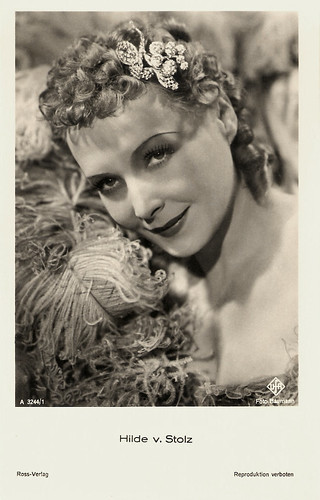
German postcard by Ross Verlag, no. A 3244/1, 1941-1944. Photo: Baumann / Ufa.
Hilde von Stolz (1903-1973) was a blonde Austrian leading lady and supporting actress in Ufa films of the 1930s and 1940s.

German postcard by Ross Verlag, no. A 3317/2, 1941-1944. Photo: Baumann / Terra. Camilla Horn in Friedemann Bach (Traugott Müller, Gustaf Gründgens, 1941).
Ethereally blonde Camilla Horn (1903-1996) was a German dancer and film star. Her breakthrough role was Gretchen in the silent film classic Faust (Friedrich Wilhelm Murnau, 1926). She also starred in some Hollywood films of the late 1920s and a few British and Italian productions.
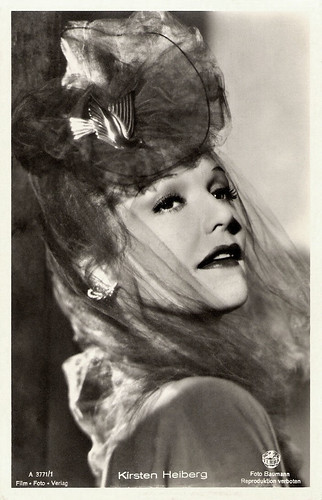
German Postcard by Film-Foto-Verlag, no. A 3371/1, 1941-1944. Photo: Baumann / Terra. Kirsten Heiberg in Liebespremiere/Love premiere (Arthur Maria Rabenalt, 1943).
Beautiful Norwegian actress and singer Kirsten Heiberg (1907-1976) was the femme fatale of the German cinema of the Third Reich. The Ufa considered her a replacement for Marlene Dietrich after the latter left for Hollywood. ‘Die Heiberg’ was one of the most interesting and talented Ufa-stars, but unfortunately, she stayed somewhat in the shade of Zarah Leander.

German postcard by Ross-Verlag, no. 3404/1, 1941-1944. Photo: Baumann / Terra.
Dark-haired and elegant German film actress Adelheid Seeck (1912-1973) appeared in 27 films between 1941 and 1972. Her West German films of the 1950s had class and were often selected for the Berlin International Film Festival.
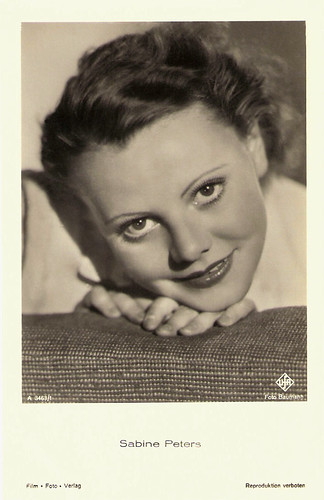
German postcard by Film-Foto-Verlag, no. A 3463/1, 1941-1944. Photo: Baumann / Ufa.
Sabine Peters (1913-1982) was a fresh-faced German theatre and film actress. During the 1930s, she played supporting and occasional leading roles in several mainstream romances and comedies for the Ufa. For Carl Froelich, she played a young student in two films but had her breakthrough as the selfish and jealous daughter of Lil Dagover in Das Mädchen Irene/The Girl Irene (1936).
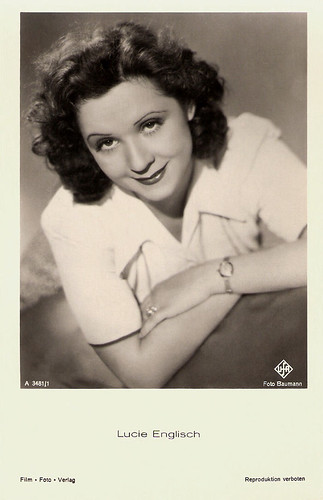
German postcard by Film-Foto-Verlag, no. A 3481/1, 1939-1940. Photo: Baumann / Ufa.
Popular Austrian folk actress Lucie Englisch (1902-1965) played leading and supporting roles on stage, in films, and on television. As the native girl with a loose tongue, she was seen in countless comedies, in both leading and supporting parts.

German postcard by Film-Foto-Verlag, Berlin, no. A 3628/1, 1941-1944. Photo: Baumann / Terra.
Swiss actress Dorothea Wieck (1908-1986) became a major star and a lesbian idol with her role as the adored teacher Fräulein von Bernburg in the German classic Mädchen in Uniform (Leontine Sagan, 1931). She made more than fifty films, but she was also a prominent stage actress of the Deutsche Theater, the Schiller Theater and other main theatres in Berlin.
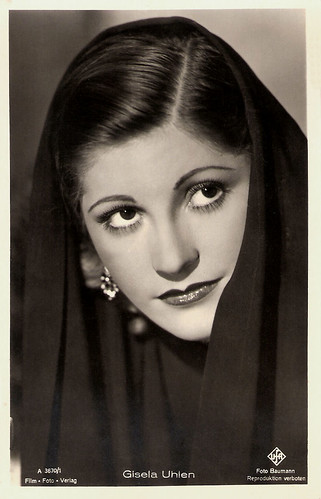
German postcard by Film-Foto-Verlag, no. A 3670/1, 1941-1944. Photo: Baumann / Ufa.
Charming German film actress Gisela Uhlen (1919-2007) appeared in over 60 films, 80 TV productions and more than 100 stage plays. She was a Ufa diva during the Third Reich, moved to East Germany during the Cold War, and finally became one of the grande dames of the German stage and television.

German postcard by Film-Foto-Verlag, no. A 3707/2, 1941-1944. Photo: Baumann / Ufa.
Egyptian-born singer, dancer and actress of Hungarian descent Marika Rökk (1913-2004) was the last film diva of the Ufa. She was an immensely talented musical performer who could tap with the rhythm and vitality of her Hollywood counterpart Eleanor Powell, and switch to balletic movements with the conviction of Cyd Charisse. Her trade mark was her Hungarian accent.
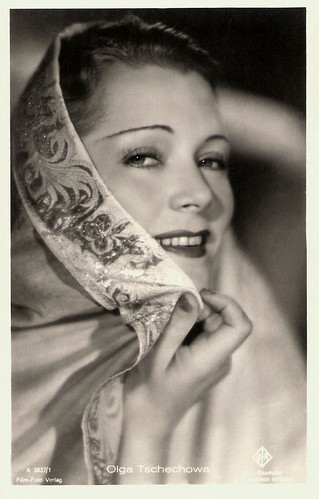
German postcard by Film-Foto-Verlag, no. A 3837/1, 1941-1944. Photo: Baumann / Ufa.
Dignified German-Russian actress Olga Tschechowa (1897-1980) was one of the most popular stars of the silent film era. She remained a mysterious person throughout her life and was reportedly a Russian agent in Nazi Germany.

German postcard by Film-Foto-Verlag, no. A 3845/1, 1941-1944. Photo: Baumann / Ufa.
German actress Hannelore Schroth (1922-1987) made her film debut at nine and had a long and successful career in theatre and cinema. She starred in Unter den Brücken/Under the Bridge (Helmut Käutner, 1945), one of the most beautiful love stories of German cinema – without any trace of propaganda.
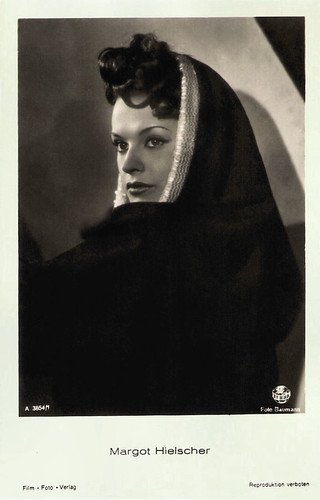
German postcard by Film-Foto-Verlag, no. A 3854/1, 1941-1944. Photo: Baumann / Terra.
German singer, film actress and costume designer Margot Hielscher (1919-2017) appeared in 60 films and 200 TV productions. She represented Germany twice at the Eurovision Song Contest, in 1957 and 1958.
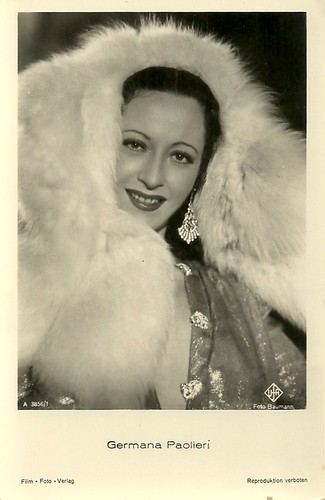
German postcard by Film-Foto-Verlag, no. A. 3856/1. Photo: Baumann / Ufa.
Germana Paolieri (1906-1998) was an Italian stage and screen actress. After the war, she also worked for radio and television. As an actress, she flourished between the early 1930s and 1981, while as a film actress, she peaked in the 1930s and early 1940s, but also the mid-1950s.
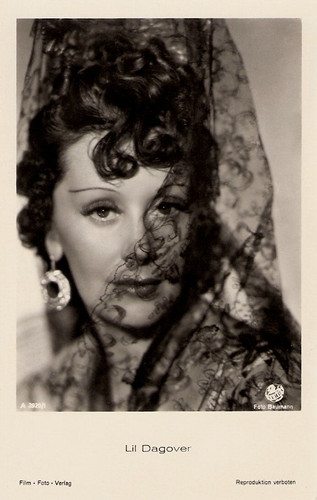
German postcard by Film-Foto-Verlag, no. A 3920/1, 1941-1944. Photo: Baumann / Terra. Lil Dagover in Musik in Salzburg/Music in Salzburg (Herbert Maisch, 1944).
German, but Dutch-born film actress Lil Dagover (1887-1980) was an exotic, dark beauty, who featured prominently during the golden age of the German silent cinema. She had her breakthrough as the prey of Dr. Caligari's monster in the classic expressionist film Das Cabinet des Dr. Caligari (1920) but gradually her fine and evanescent beauty changed and she turned into a 'Salondame', a lady of the screen. Her career would span nearly six decades.
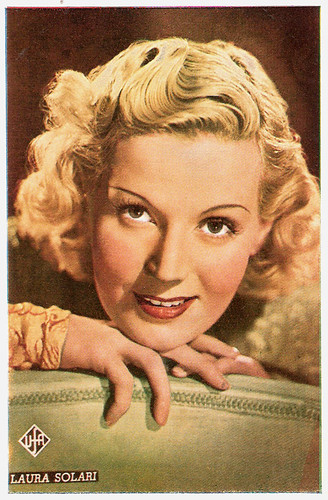
Croatian postcard by Dopisnica. Photo: Baumann / Ufa.
Laura Solari (1913–1984) was an Italian film actress. She appeared in 30 films between 1936 and 1969.
Sources: Ernst Baumann Foto Archiv 1942-1944 (Facebook), Wikipedia (German) and IMDb.
No comments:
Post a Comment